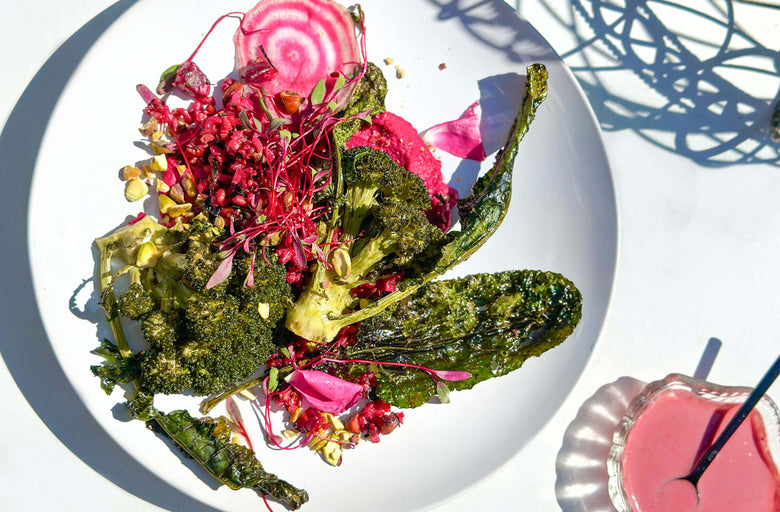If you haven't heard about the 75-minute mind-body cathartic experience that is The Class, then where have you been hiding? After a kismet connection first meeting with The Class creator, Taryn Toomey in an NYC Lululemon. In a universal move, Natalie joined Taryn and The Class just weeks before the heart-ripping and sudden death or her mother, which in turn was a journey of teaching through personal healing. Most recently, Natalie returned back to her home of LA (and literally moved back into her childhood home her husband and their pup) to bring The Class's "peace through strength" modalities to the West Coast. Be forewarned: this woman's effervescence and light will have you digging deep, and emerging from The Class stronger (both mentally and physically) than how you went in.
What has the journey been like to where you are today?
I’m from LA, but I moved to New York for college when I was 17 and just stayed. I was there for 13 years, but moved back (to LA) just five months ago. I studied theater and was an actor for a long time. I studied a lot of movement theater — Suzuki, Viewpoints, Gratowski. I studied all the modalities that had to do with finding story and character and emotion through the body. It’s about using your body as a route to the soul.
There were multiple tracks I could’ve gone on at NYU and they distilled those pretty clearly. At first, I was in a more cerebral program that was all about playwright. It was about the words and using the words and intellectualizing the words. Because I have more of a type A brain, I knew that I needed to come at the work from a different angle. I was always consciously seeking out expression through my body.
It was 10 months after I graduated that I got hired to dance for David Byrne. I was on a world tour with him for a year and truly, that was the first time I’d ever danced. Through that, I discovered how to create a cathartic experience for thousands of people using pop music, a creative genius frontman, and my body. That lead me to work with more bands and more physical theater. But truthfully, the instability of the lifestyle was very rough on me. There were odd jobs I had to keep between gigs, and that is just not who I am.

How did the David Byrne job come up?
One of the choreographers that I was working with at NYU was a choreographer for him — her theater company was my zenith so I kept in contact with her. All I wanted to do was work for her company because I was all about downtown theater. I took every class that her husband taught at NYU. The movement was so unique and the way they told stories was so refreshing and new. I’m not surprised that David scooped her up to choreograph the St. Vincent tour.
The interview process for David was like a chorus line. Everybody had numbers on and then every hour and a half, people were cut. I really didn’t know what I was doing. I guess you could call it contemporary movement, but it was definitely my first time doing that kind of movement.
David is so idiosyncratic —the best thing was seeing the world through his lens. Once in Albuquerque, he was like, ‘Do you guys all want to go to this church that has sacred dirt?’ We were all like, ‘Yes, we do. We would really love to do that.’

Did you have a spiritual or religious upbringing?
My mom was a nun and all my aunts and uncles were nuns or priests. My mom served the least amount — 5 years — and my uncle served the most — 15 years. My dad was Catholic and studied psychology. From psychology, he decided that he wanted to go into medicine. I grew up talking about the shadow, dream analysis, the subconscious and all of that. And with my acting, it was all about discovering the psychology of a person that isn’t you — about what motivates a person.
How did you and Taryn meet?
I was really fed up with bartending, the odd job I was doing at the time, and got myself into too many late nights and early sunrises. I decided that I would try working for a company that would promote my well-being. Lululemon ended up being that company, and Taryn was a regular there. She would come in and we just hit it off. It was very friendly. Then somebody told me to try her class, but back then, you had to email her directly. It was always held in the gyms of people’s buildings — you’d put $20 in a bucket and it all went to this orphanage in Peru. I was like, ‘Wow, this sounds like Prohibition fitness and I’m totally into it.’
It’s hard to describe, but meeting Taryn was one of those instances when you immediately click with somebody — it felt like lightning. There was this electricity and joy between us that is so rare. After my second class, she asked if I’d thought about teaching. I’d actually been trying to find something I loved enough to go into teacher training for, but I wasn’t finding that connection.
In a very Taryn way, she intuited that it would be the right move. And in typical Nat style, I create the structure by which this could happen. I proposed a work-study program that was basically setting her up and breaking her down in exchange for The Class. I took copious notes. I made stick figures of the moves that she was doing and made notes about how I felt while doing them. She allowed me to teach my friends, so I taught religiously. Every Sunday, I rented space in Greenpoint — I started with two people in my living room and by the time I felt that I wanted her to witness how much I’d grown, I went in for feedback. I eventually had 35 women every Sunday consistently in Greenpoint. She came in and gave me great notes. She felt where I was. Thee days after teaching my first Class, my mom died. It was all very synergistic — I had come to this place where I was developing into Taryn’s healing modality, and then very desperately needed it.

Do you remember what you thought of The Class the first time you took it?
The first thing that comes to mind is remembering how little water I wanted to drink afterwards because it was so painful to sit down and pee. There was also profuse sweating. I remember knowing that this kind of work requires community and collective energy. I was used to watching Paula Dean on a treadmill alone at a Crunch gym — I was getting my body in treadmill mode and in my mind I was learning how to bake a cake. My exercise routine had my mind and body completely dissociated. With The Class, I was immediately interested in how she was peaking the more artistic part of me.
The community that comes to The Class really is a testament to Taryn’s magnetism. It attracts a lot of Tribeca moms as well, because she is one, right? She’s able to tap into this role of, ‘If I can unleash, you can unleash.’ She lets them know that she feels the weight of new motherhood as much they do. I think there are many different kinds of people that come to The Class, but I also do think that there are some people who are drawn to the aspirational qualities, and then they get surprised by the inspirational qualities. Then there are those who come for inspiration and hopefully leave feeling totally satisfied with that experience.
Since the community has begun to expand, and since I’ve brought the method to LA, I’ve learned that we all have those same pressures of self-consciousness. We just exhibit them differently. That might be stilettos and a blazer with your baby, or it might be your Burning Man braids — whatever it is, every type of person still experiences the need to push against their own story.

What’s your process of preparing for, and then leading The Class like?
I feel so grateful for my performance background, because it was all about presence. There is a level of structure and preparation that you need to create and the playlist takes you on a journey. In that playlist lives the highs and the lows that I take the group through. What’s actually said is not rehearsed — I feed off of the energy in the room. I feed off of what I am particularly thinking of or going through, or something that I’ve read or a conversation I’ve just had. I get to know my students pretty well — I look around the room and something always sparks me by looking at a person and understanding what they’re going through. It’s really about being absorbed in the moment and feeling into how the music and the energy respond to each other.
Right now, I teach six to seven LA classes a week — Sunday through Friday and then an event here or there. Though, we’ll have more teachers joining us soon.
The Class is also not about re-creating. It’s about stepping into the space and being truthful to myself. I’ve noticed — and I make this mistake all time — that if I plan for something, it’ll take me out of what’s really happening. I’m a bit of a poetry geek, so there are times when I bring in a poet. I’ll weave a poem through class until the gift of their words has landed at the end.
I have to face walls in this work — the major one is that since I’m not the creator of this method, I’ve had to find confidence in my own voice and in staying true to the work, while also being true to my own take on it. I think with any mentorship, the way you learn is by emulating. At a certain point — for your own growth and development — that emulation needs to transform into taking risks. Those risks come from an authentic voice development.

What’s it like to work alongside your best friend?
Taryn is my sister-wife. We complement each other in so many ways. I think that when she struggles, I can help balance where she’s at. Beyond that, I’ve always wanted to work for a strong woman entrepreneur. In this world of human empowerment, the fact that she is so deeply passionate about it and entrenched in it is so inspiring.
We both listen to music on the daily — we’re both feeding off of each other’s experiences. We’ve helped each other through very difficult times in the past three years, personally and professionally. At different times, we’ve lifted each other up when the other has tripped. What’s amazing about Taryn is how clear her vision is and how clear her aesthetic is. That’s not my strength, so I love being able to watch her flourish in her strength. She is a true visionary.
Is The Class based on any shamanic principles?
Taryn feels things very intensely in her body — it’s taken me a while to realize that I have a lag time with my bodily response. Her response is so immediate. She feels something, she articles it, and BOOM it’s out there. For me, based on my family and history, I’ve learned to choose precisely when and how I am going to react. That can be both helpful and harmful. It’s interesting for me to come to the work from those very different angles.

What’s your idea of legacy?
I feel that my main goal in life is to help people realize that they’re already home. I want to be remembered as somebody who helped others reconnect with their bodies. Whether that’s my future children or a community of teenagers — men and women — I want to help people find a way to speak to themselves that returns them to themselves.
For people who have experienced trauma, or people who have experienced hardship — and we’ve all experienced hardship — there's such an intense cultural tendency to look for ourselves outside of ourselves. I think that practice is in community. I feel very strongly about creating community, so I hope that I’m also remembered as somebody who helped bring people together around, again, this notion of finding home within oneself.
We have to celebrate each other's differences! And the last thing I want to say is that I just want us all to strike through the word “guru” — I am not a guru, I’m a “helper”. I’m simply somebody who offers suggestions.






